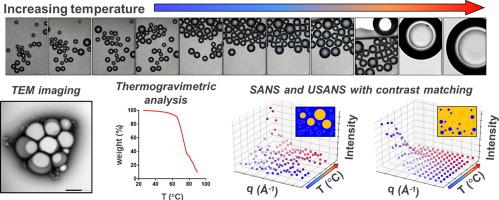Journal of Colloid and Interface Science ( IF 9.9 ) Pub Date : 2021-08-31 , DOI: 10.1016/j.jcis.2021.08.162 Mark Louis P Vidallon 1 , Luke W Giles 1 , Matthew J Pottage 1 , Calum S G Butler 1 , Simon A Crawford 2 , Alexis I Bishop 3 , Rico F Tabor 1 , Liliana de Campo 4 , Boon Mian Teo 1

|
Perfluorocarbon emulsion droplets are hybrid colloidal materials with vast applications, ranging from imaging to drug delivery, due to their controllable phase transition into microbubbles via heat application or acoustic droplet vapourisation. The current work highlights the application of small- and ultra-small-angle neutron scattering (SANS and USANS), in combination with contrast variation techniques, in observing the in situ phase transition of polydopamine-shelled, perfluorocarbon (PDA/PFC) emulsion droplets with controlled polydispersity into microbubbles upon heating. We correlate these measurements with optical and transmission electron microscopy imaging, dynamic light scattering, and thermogravimetric analysis to characterise these emulsions, and observe their phase transition into microbubbles. Results show that the phase transition of PDA/PFC droplets with perfluorohexane (PFH), perfluoropentane (PFP), and PFH–PFP mixtures occur at temperatures that are around 30–40 °C higher than the boiling points of pure liquid PFCs, and this is influenced by the specific PFC compositions (perfluorohexane, perfluoropentane, and mixtures of these PFCs). Analysis and model fitting of neutron scattering data allowed us to monitor droplet size distributions at different temperatures, giving valuable insights into the transformation of these polydisperse, emulsion droplet systems.
中文翻译:

使用中子散射跟踪聚多巴胺壳全氟化碳乳液液滴的热触发相变成微泡
全氟化碳乳液液滴是混合胶体材料,具有广泛的应用,从成像到药物输送,由于它们通过加热或声学液滴汽化可控制相转变为微泡。目前的工作突出了小角度和超小角度中子散射(SANS 和 USANS)结合对比度变化技术在原位观测中的应用。聚多巴胺壳的全氟化碳 (PDA/PFC) 乳液液滴在加热时具有可控的多分散性,转变为微泡。我们将这些测量与光学和透射电子显微镜成像、动态光散射和热重分析相关联,以表征这些乳液,并观察它们向微泡的相变。结果表明,PDA/PFC 液滴与全氟己烷 (PFH)、全氟戊烷 (PFP) 和 PFH-PFP 混合物的相变发生在比纯液体 PFC 沸点高约 30-40 °C 的温度下,这受特定 PFC 成分(全氟己烷、全氟戊烷和这些 PFC 的混合物)的影响。



























 京公网安备 11010802027423号
京公网安备 11010802027423号